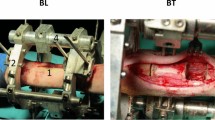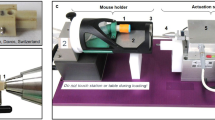Abstract
Understanding the evolution of callus mechanical properties over time provides insights in the mechanobiology of fracture healing and tissue differentiation, can be used to validate numerical models, and informs clinical practice. Bone transport experiments were performed in sheep, in which a distractor type Ilizarov was implanted. The forces through the fixator evolution were measured and the callus stiffness was estimated from these forces. Computerized tomography images were taken and bone volume of the callus at different stages was obtained. The results showed that the maximum bone tissue production rate (0.146 cm3/day) was achieved 20 days after the end of the distraction phase. 50 days after the end of the distraction phase, the callus was ossified completely and had its maximum volume, 6–10 cm3. In addition, 80–90% of the load sustained by the operated limb was recovered and the callus stiffness increased exponentially until 5.4–11.4 kN/mm, still below 10% of the healthy level of callus stiffness. The effects of the bony bridging of the callus and the time of the fixator removal on callus force, stiffness and volume were analyzed. These outcomes allowed relating quantifiable biological aspects (callus volume and tissue production rate) with mechanical parameters (callus force and stiffness) using data from the same experiment.







Similar content being viewed by others
References
Aarnes, G. T., H. Steen, L. P. Kristiansen, E. Festø, and P. Ludvigsen. Optimum loading mode for axial stiffness testing in limb lengthening. J. Orthop. Res. 24:348–354, 2006.
Aarnes, G. T., H. Steen, P. Ludvigsen, N. A. Waanders, R. Huiskes, and S. A. Goldstein. In vivo assessment of regenerate axial stiffness in distraction osteogenesis. J. Orthop. Res. 23:494–498, 2005.
Aronson, J. Temporal and spatial increases in blood flow during distraction osteogenesis. Clin. Orthop. Relat. Res. 301:124–131, 1994.
Aronson, J., and J. H. Harp. Mechanical forces as predictors of healing during tibial lengthening by distraction osteogenesis. Clin. Orthop. Relat. Res. 301:73–79, 1994.
Aronson, J., B. H. Harrison, C. L. Stewart, and J. H. Harp, Jr. The histology of distraction osteogenesis using different external fixators. Clin. Orthop. Relat. Res. 241:106–116, 1989.
Aronson, J., X. C. Shen, R. A. Skinner, W. R. Hogue, T. M. Badger, and C. K. Lumpkin, Jr. Rat model of distraction osteogenesis. J. Orthop. Res. 15:221–226, 1997.
Brunner, U. H., J. Cordey, L. Schweiberer, and S. M. Perren. Force required for bone segment transport in the treatment of large bone defects using medullary nail fixation. Clin. Orthop. Relat. Res. 301:147–155, 1994.
Claes, L. E., and J. L. Cunningham. Monitoring the mechanical properties of healing bone. Clin. Orthop. Relat. Res. 467:1964–1971, 2009.
Claes, L., R. Grass, T. Schmickal, B. Kisse, C. Eggers, H. Gerngross, W. Mutschler, M. Arand, T. Wintermeyer, and A. Wentzensen. Monitoring and healing analysis of 100 tibial shaft fractures. Langenbecks. Arch. Surg. 387:146–152, 2002.
Claes, L., J. Laule, K. Wenger, G. Suger, U. Liener, and L. Kinzl. The influence of stiffness of the fixator on maturation of callus after segmental transport. J. Bone Jt. Surg. Br. 82:142–148, 2000.
Claes, L. E., H.-J. Wilke, P. Augat, S. Rübenacker, and K. J. Margevicius. Effect of dynamization on gap healing of diaphyseal fractures under external fixation. Clin. Biomech. (Bristol, Avon). 10:227–234, 1995.
Cunningham, J. L., J. Kenwright, and C. J. Kershaw. Biomechanical measurement of fracture healing. J. Med. Eng. Technol. 14:92–101, 1990.
De Pablos Jr, J., and J. Canadell. Experimental physeal distraction in immature sheep. Clin. Orthop. Relat. Res. 250:73–80, 1990.
Delloye, C., G. Delefortrie, L. Coutelier, and A. Vincent. Bone regenerate formation in cortical bone during distraction lengthening. An experimental study. Clin. Orthop. Relat. Res. 250:34–42, 1990.
Duda, G. N., K. Eckert-Hubner, R. Sokiranski, A. Kreutner, R. Miller, and L. Claes. Analysis of inter-fragmentary movement as a function of musculoskeletal loading conditions in sheep. J. Biomech. 31:201–210, 1998.
Dwyer, J. S., P. J. Owen, G. A. Evans, J. H. Kuiper, and J. B. Richardson. Stiffness measurements to assess healing during leg lengthening. A preliminary report. J. Bone. Jt. Surg. Br. 78:286–289, 1996.
Evans, F. G. Mechanical Properties of Bone. Springfield: Charles C. Thomas Publisher, 1973.
Floerkemeier, T., W. Aljuneidi, J. Reifenrath, N. Angrisani, D. Rittershaus, D. Gottschalk, S. Besdo, A. Meyer-Lindenberg, H. Windhagen, and F. Thorey. Telemetric in vivo measurement of compressive forces during consolidation in a rabbit model. Technol. Health Care 19:173–183, 2011.
Floerkemeier, T., F. Thorey, C. Hurschler, M. Wellmann, F. Witte, and H. Windhagen. Stiffness of callus tissue during distraction osteogenesis. Orthop. Traumatol. Surg. Res. 96:155–160, 2010.
Forriol, F., L. Denaro, U. G. Longo, H. Taira, N. Maffulli, and V. Denaro. Bone lengthening osteogenesis, a combination of intramembranous and endochondral ossification: an experimental study in sheep. Strateg. Trauma Limb Reconstr. 5:71–78, 2010.
Gardner, T. N., M. Evans, H. Simpson, and J. Kenwright. Force-displacement behaviour of biological tissue during distraction osteogenesis. Med. Eng. Phys. 20:708–715, 1998.
Grasa, J., M. J. Gomez-Benito, L. A. Gonzalez-Torres, D. Asiain, F. Quero, and J. M. Garcia-Aznar. Monitoring in vivo load transmission through an external fixator. Ann. Biomed. Eng. 38:605–612, 2010.
Hente, R., J. Cordey, and S. M. Perren. In vivo measurement of bending stiffness in fracture healing. Biomed. Eng. Online 2:8, 2003.
Ilizarov, G. A. The tension-stress effect on the genesis and growth of tissues. Part I. The influence of stability of fixation and soft-tissue preservation. Clin. Orthop. Relat. Res. 238:249–281, 1989.
Ilizarov, G. A. The tension-stress effect on the genesis and growth of tissues: Part II. The influence of the rate and frequency of distraction. Clin. Orthop. Relat. Res. 239:263–285, 1989.
Isaksson, H., O. Comas, C. C. van Donkelaar, J. Mediavilla, W. Wilson, R. Huiskes, and K. Ito. Bone regeneration during distraction osteogenesis: mechano-regulation by shear strain and fluid velocity. J. Biomech. 40:2002–2011, 2007.
Kojimoto, H., N. Yasui, T. Goto, S. Matsuda, and Y. Shimomura. Bone lengthening in rabbits by callus distraction. The role of periosteum and endosteum. J. Bone Jt. Surg. Br. 70:543–549, 1988.
Leong, P. L., and E. F. Morgan. Measurement of fracture callus material properties via nanoindentation. Acta Biomater. 4:1569–1575, 2008.
Leong, P. L., and E. F. Morgan. Correlations between indentation modulus and mineral density in bone-fracture calluses. Integr. Comp. Biol. 49:59–68, 2009.
Manjubala, I., Y. Liu, D. R. Epari, P. Roschger, H. Schell, P. Fratzl, and G. N. Duda. Spatial and temporal variations of mechanical properties and mineral content of the external callus during bone healing. Bone 45:185–192, 2009.
Mora-Macías, J., E. Reina-Romo, and J. Domínguez. Distraction device to estimate the axial stiffness of the callus in vivo. Med. Eng. Phys., 2015 (Under review).
Mora-Macías, J., E. Reina-Romo, J. Morgaz, and J. Domínguez. In vivo gait analysis during bone transport. Ann. Biomed. Eng. 2015. doi:10.1007/s10439-015-1262-2.
Ohyama, M., Y. Miyasaka, M. Sakurai, A. T. Yokobori, Jr., and S. Sasaki. The mechanical behavior and morphological structure of callus in experimental callotasis. Biomed. Mater. Eng. 4:273–281, 1994.
Okazaki, H., T. Kurokawa, K. Nakamura, T. Matsushita, K. Mamada, and H. Kawaguchi. Stimulation of bone formation by recombinant fibroblast growth factor-2 in callotasis bone lengthening of rabbits. Calcif. Tissue Int. 64:542–546, 1999.
Panjabi, M. M., R. W. Lindsey, S. D. Walter, and A. A. White, 3rd. The clinician’s ability to evaluate the strength of healing fractures from plain radiographs. J. Orthop. Trauma 3:29–32, 1989.
Panjabi, M. M., S. D. Walter, M. Karuda, A. A. White, and J. P. Lawson. Correlations of radiographic analysis of healing fractures with strength: a statistical analysis of experimental osteotomies. J. Orthop. Res. 3:212–218, 1985.
Preininger, B., S. Checa, F. L. Molnar, P. Fratzl, G. N. Duda, and K. Raum. Spatial-temporal mapping of bone structural and elastic properties in a sheep model following osteotomy. Ultrasound Med. Biol. 37:474–483, 2011.
Reina-Romo, E., M. J. Gomez-Benito, J. Dominguez, and J. M. Garcia-Aznar. A lattice-based approach to model distraction osteogenesis. J. Biomech. 45:2736–2742, 2012.
Reina-Romo, E., M. J. Gomez-Benito, J. Dominguez, F. Niemeyer, T. Wehner, U. Simon, and L. E. Claes. Effect of the fixator stiffness on the young regenerate bone after bone transport: computational approach. J. Biomech. 44:917–923, 2011.
Reina-Romo, E., M. J. Gomez-Benito, J. M. Garcia-Aznar, J. Dominguez, and M. Doblare. Modeling distraction osteogenesis: analysis of the distraction rate. Biomech. Model. Mechanobiol. 8:323–335, 2009.
Reina-Romo, E., M. J. Gomez-Benito, J. M. Garcia-Aznar, J. Dominguez, and M. Doblare. Growth mixture model of distraction osteogenesis: effect of pre-traction stresses. Biomech. Model. Mechanobiol. 9:103–115, 2010.
Reina-Romo, E., M. J. Gomez-Benito, J. M. Garcia-Aznar, J. Dominguez, and M. Doblare. An interspecies computational study on limb lengthening. Proc. Inst. Mech. Eng. H 224:1245–1256, 2010.
Reina-Romo, E., M. J. Gomez-Benito, A. Sampietro-Fuentes, J. Dominguez, and J. M. Garcia-Aznar. Three-dimensional simulation of mandibular distraction osteogenesis: mechanobiological analysis. Ann. Biomed. Eng. 39:35–43, 2011.
Richards, M., J. A. Goulet, M. B. Schaffler, and S. A. Goldstein. Temporal and spatial characterization of regenerate bone in the lengthened rabbit tibia. J. Bone Miner. Res. 14:1978–1986, 1999.
Richardson, J. B., J. L. Cunningham, A. E. Goodship, B. T. O’Connor, and J. Kenwright. Measuring stiffness can define healing of tibial fractures. J. Bone Jt. Surg. Br. 76:389–394, 1994.
Rodriguez-Florez, N., M. L. Oyen, and S. J. Shefelbine. Insight into differences in nanoindentation properties of bone. J. Mech. Behav. Biomed. Mater. 18:90–99, 2013.
Ryan, T. P. Modern Regression Methods. Hoboken, NJ: Wiley, 2009.
Simon, U., P. Augat, A. Ignatius, and L. Claes. Influence of the stiffness of bone defect implants on the mechanical conditions at the interface–a finite element analysis with contact. J. Biomech. 36:1079–1086, 2003.
Waanders, N. A., M. Richards, H. Steen, J. L. Kuhn, S. A. Goldstein, and J. A. Goulet. Evaluation of the mechanical environment during distraction osteogenesis. Clin. Orthop. Relat. Res. 349:225–234, 1998.
Webb, J., G. Herling, T. Gardner, J. Kenwright, and A. H. Simpson. Manual assessment of fracture stiffness. Injury 27:319–320, 1996.
Windhagen, H., S. Kolbeck, H. Bail, A. Schmeling, and M. Raschke. Quantitative assessment of in vivo bone regeneration consolidation in distraction osteogenesis. J. Orthop. Res. 18:912–919, 2000.
Yasui, N., H. Kojimoto, H. Shimizu, and Y. Shimomura. The effect of distraction upon bone, muscle, and periosteum. Orthop. Clin. North Am. 22:563–567, 1991.
Acknowledgments
The authors gratefully acknowledge the research support of the Consejería de Innovacion, Ciencia y Empleo de la Junta de Andalucía (P09-TEP-5195) and the FPU grant of the Ministerio de Educación del Gobierno de España (AP2010-5061). The authors are also grateful to the University of Zaragoza for its collaboration.
Conflict of interest
The authors have no financial or personal relationships that could inappropriately influence the contents of this paper.
Author information
Authors and Affiliations
Corresponding author
Additional information
Associate Editor Peter E. McHugh oversaw the review of this article.
Rights and permissions
About this article
Cite this article
Mora-Macías, J., Reina-Romo, E., López-Pliego, M. et al. In Vivo Mechanical Characterization of the Distraction Callus During Bone Consolidation. Ann Biomed Eng 43, 2663–2674 (2015). https://doi.org/10.1007/s10439-015-1330-7
Received:
Accepted:
Published:
Issue Date:
DOI: https://doi.org/10.1007/s10439-015-1330-7




